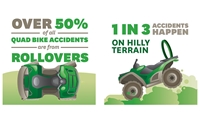Be aware of battery fires
WORDS AND IMAGES SUPPLIED BY FMG INSURANCE
Lithium batteries are becoming a more common sight on farms these days and are used in numerous devices around the home. While they are now a part of modern life the batteries can create a fire risk, particularly if they are damaged.
When you are charging your devices – lithium-ion batteries can in some cases overheat, catch fire, or explode.
We have seen clients who have suffered losses to their buildings, contents and vehicles caused by lithium-ion batteries. One of these was a total loss house fire that cost $1 million dollars to replace. The fire was caused by batteries charging in the garage.
Many modern devices are powered by lightweight, high-energy lithium-ion (liion) batteries. These power our phones, laptops, tools, e-bikes, e-scooters, vapes and even cars.
Lithium-ion batteries can catch fire for several reasons:
• Overcharging or using incorrect chargers.
• Overheating or exposure to extreme temperatures (hot or cold).
• Physical damage like drops or punctures.
• Short-circuits, malfunctions, or manufacturing defects.
When these batteries fail, they can emit toxic, flammable, and explosive gas that can cause intense, self -sustaining fires that are difficult to extinguish so it is important that you read and follow the prevention advice below:
1. Avoid leaving devices charging unattended or overnight.
2. Disconnect fully charged batteries and devices.
3. Avoid exposing devices to heat, moisture or direct sunlight.
4. Only buy genuine devices and equipment.
5. Only buy devices and equipment from trustworthy manufacturers and retailers.
6. Only use the correct and approved chargers for your device.
7. Never charge devices on flammable surfaces.
8. Never charge your devices in bed, or on flammable material or surfaces.
9. Discard damaged devices showing signs of swelling, leakage, or overheating.
10. Installing approved smoke or heat alarms in charging areas will help give an early warning of extreme battery overheating.
Back to Real Farmer
Related

The versatility of quad bikes makes them a popular choice on farm. However, the fact that they are s...
Read More

Following a hair-raising encounter, Barry and Pauline George breath a sight of relief, grateful they...
Read More